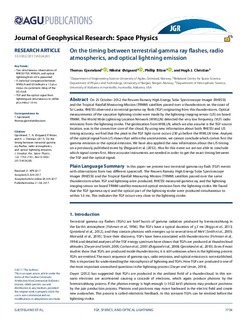| dc.contributor.author | Gjesteland, Thomas | |
| dc.contributor.author | Østgaard, Nikolai | |
| dc.contributor.author | Bitzer, Phillip | |
| dc.contributor.author | Christian, Hugh J. | |
| dc.date.accessioned | 2018-01-23T12:31:41Z | |
| dc.date.available | 2018-01-23T12:31:41Z | |
| dc.date.created | 2017-10-30T13:43:44Z | |
| dc.date.issued | 2017 | |
| dc.identifier.citation | Journal of Geophysical Research - Space Physics . 2017, 122 (7), 7734-7741. | nb_NO |
| dc.identifier.issn | 2169-9402 | |
| dc.identifier.uri | http://hdl.handle.net/11250/2479080 | |
| dc.description.abstract | On 25 October 2012 the Reuven Ramaty High Energy Solar Spectroscope Imager (RHESSI) and the Tropical Rainfall Measuring Mission (TRMM) satellites passed over a thunderstorm on the coast of Sri Lanka. RHESSI observed a terrestrial gamma ray flash (TGF) originating from this thunderstorm. Optical measurements of the causative lightning stroke were made by the lightning imaging sensor (LIS) on board TRMM. The World Wide Lightning Location Network (WWLLN) detected the very low frequency (VLF) radio emissions from the lightning stroke. The geolocation from WWLLN, which we also assume is the TGF source location, was in the convective core of the cloud. By using new information about both RHESSI and LIS timing accuracy, we find that the peak in the TGF light curve occurs 230 μs before the WWLLN time. Analysis of the optical signal from LIS shows that within the uncertainties, we cannot conclude which comes first: the gamma emission or the optical emission. We have also applied the new information about the LIS timing on a previously published event by Østgaard et al. (2012). Also for this event we are not able to conclude which signal comes first. More accurate instruments are needed in order to get the exact timing between the TGF and the optical signal. | nb_NO |
| dc.language.iso | eng | nb_NO |
| dc.publisher | Wiley-Blackwell | nb_NO |
| dc.rights | Attribution-NonCommercial-NoDerivatives 4.0 Internasjonal | * |
| dc.rights | Attribution-NonCommercial-NoDerivatives 4.0 Internasjonal | * |
| dc.rights.uri | http://creativecommons.org/licenses/by-nc-nd/4.0/deed.no | * |
| dc.title | On the timing between terrestrial gamma ray flashes, radio atmospherics, and optical lightning emission | nb_NO |
| dc.type | Journal article | nb_NO |
| dc.type | Peer reviewed | nb_NO |
| dc.description.version | publishedVersion | nb_NO |
| dc.source.pagenumber | 7734-7741 | nb_NO |
| dc.source.volume | 122 | nb_NO |
| dc.source.journal | Journal of Geophysical Research - Space Physics | nb_NO |
| dc.source.issue | 7 | nb_NO |
| dc.identifier.doi | 10.1002/2017JA024285 | |
| dc.identifier.cristin | 1508949 | |
| dc.description.localcode | nivå2 | nb_NO |
| cristin.unitcode | 201,15,3,0 | |
| cristin.unitname | Institutt for ingeniørvitenskap | |
| cristin.ispublished | true | |
| cristin.fulltext | original | |
| cristin.qualitycode | 2 | |

